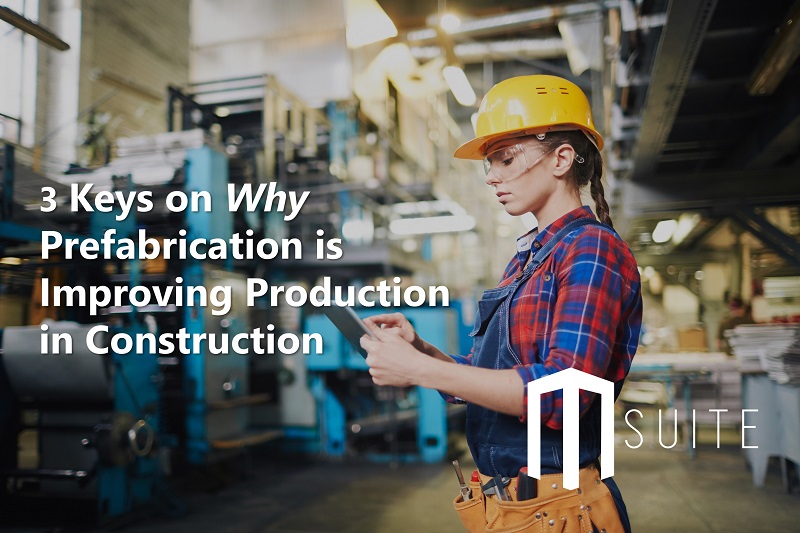Before diving into the best practices and benefits around Prefabrication, it’s important to understand what it entails. Prefabrication refers to fabricating assemblies (components of a building) in a controlled factory setting. From whole buildings or rooms to much smaller elements, buildings are becoming increasingly constructed off-site in secure facilities and then transported to the job site for assembly. Prefabrication has proven to increase safety by working in a much more controlled environment, while also maximizing production through easily repeatable steps.
Read on if you’re curious about prefab and are interested in implementing the practice in your projects. This article explores expert advice on prefabrication benefits, myths, and best practices.
1. Common prefab misunderstandings
Myth #1: Prefab is primarily impactful in creating building features or large components
False. Prefabrication can make an impact by improving the production of a single repeatable feature or very small building elements. Improving the bottom line can start small but lead to large numbers.
- Prefabrication doesn’t have to include the entire building or room. Prefabrication can be used for something like smaller elements like trusses.
- It’s common for contractors to jump on office room, but Prefabrication can be applied to a single component, not a fully finished building, and doesn’t have to be expensive either. It can be quite simple, but it’s about being design-led rather than only building in the factory.
Myth #2: Prefabrication only creates unattractive boxes
This is another persistent myth, but untrue. Just because something is made in a factory doesn’t mean it must be bland. On the contrary, you can prefabricate beautifully designed buildings efficiently and cost-effectively with the proper practices and technologies.
Prefabrication techniques have changed dramatically in the last few years, and contractors are leveraging technology and data to produce designs that are flexible and responsive to client needs. Design teams are innovating in function and method.
Don’t let old myths and misconceptions stop you from exploring Prefabrication. There are a lot of advancements in the areas of prefab that give construction professionals more flexibility to design great-looking buildings while still allowing for customization on the jobsite.
2. Unlocking serious production potential with prefab
Today, Prefabrication benefits the entire project and team in numerous ways, including:
- Saving Money. Since Prefabrication happens in a factory or manufacturing site, you have more control over your environment, schedule, and timeline. Having a handle on all these things helps minimize unexpected costs.
In addition, prefab enables automation in a factory setting, resulting in fewer errors and labor hours to keep your costs in check.
- Eliminating weather and project delays. Prefab allows projects to be weather-independent. Building something in a controlled environment helps you avoid weather-related and other external disruptions to complete projects faster.
- Environmentally friendly. Leveraging Prefabrication leads to fewer errors and delays, which means lower energy consumption and less waste — especially when used with other technologies.
Prefabrication combined with other technology, such as VR and AR, can enhance our production in the factory with excellent quality. In addition, machinery and prefab concept because this machine produces almost zero waste.
- Increased quality. Prefab technology and automation guarantee that materials are produced with consistent quality. Prefab allows you to control quality better. All the BIM data in Revit is carried over into manufacturing, so what you created is exactly what was modeled and approved by the design team.
- Improving safety. Working in a controlled environment means strict safety procedures can be enforced. This is especially important when there are social distancing measures in place. And since the work happens inside a factory site, employees encounter fewer job site-related hazards and unexpected events.
- Greater flexibility. Because components are prefabricated off-site, it’s easier to transport, assemble, and disassemble different elements. This gives you more flexibility when implementing design changes or relocating materials from one location to another.
3. Ready to get started? Start small, but with real projects.
If you’re ready for Prefabrication, experts recommend starting small—but doing it with real projects, so you can learn and improve as you go.
Start your path with a single component (e.g., a 2D panel) that is easier to transport to the job site.
With Prefabrication, most contractors begin with a small fabrication shop around 3,000 square feet with a single machine. If you’re jumping headfirst with an attempt to immediately prefabricate multiple components, things can get a little more complex.
When starting with Prefabrication, you want to ensure that you have the correct data and model to translate and import into manufacturing techniques and technologies. This is critical to building your foundation with a unified building approach properly.
Implementing Prefabrication successfully requires solid skills and knowledge around BIM and coordination, so hiring team members accordingly is recommended. In addition, you need the best people to ensure that your prefabricated elements will fit perfectly on the jobsite.








